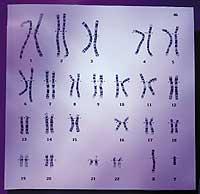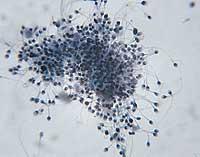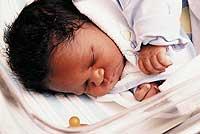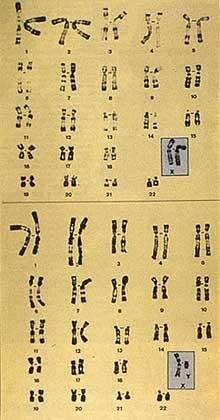On the border between sexes
2004/07/01 Lexartza Artza, Irantzu - Elhuyar Zientziaren Komunikazioa Iturria: Elhuyar aldizkaria

Defining the sex of people is not as simple as it seems. Scientists are defining themselves more and more about it, but if we limit ourselves to two options, it is not easy to give a circular answer.
It is generally accepted that biological sex is marked by a pair of chromosomes. Humans normally have forty-six chromosomes, twenty-three of fathers and so many of mothers, organized in couples. Twenty-two of these couples lack sex determination functions. This work is done on par 26 using X and Y chromosomes.
To create woman, father and mother give an X chromosome to form the XX pair. For the creation of man the XY pair is formed with chromosome X by the mother and chromosome Y by the father.
Although the full chromosomal image or karyotype is defined since creation, in all human embryos there are tissues to develop both sexes in the first weeks. When the embryo is about eight weeks old, a chain of biochemical events begins to develop sexual characters according to chromosomes.

In embryos with XY chromosome this process is initiated by the SRY gene of the Y chromosome. This gene is similar to a general switch. When it's running, turn on other genes, such as SOX-9, to start forming the male gonad or testicles. At the same time, the female tissues present in the embryo begin to disappear, since they do not receive development orders.
In embryos XX there is no SRY. There is, therefore, no sign and other genes initiate the development of female or ovarian gonads. In this situation, male tissues are those that begin to disappear.
Once the sexual glands have been developed, they flow hormones in the blood and reach all embryo cells. They are powerful chemical substances that cause, among other things, the development of the external and internal genitals.
Androgens, for example, control the development of male secondary sexual characters. In women, estrogenous hormones and progesterone predominate. The female and male hormones, in any case, appear in both men and women, being the quantity that limits their influence.

All these processes give rise to the formation of female or male sexual characters: gonadas, genitals, secondary sexual characters... and when the baby is born society places him in one of the two sides of the border: the girl or the boy.
Chromosomal and Gene Incidences
However, cases that do not comply with this model are less frequent. In the development of chromosomes, genes and sexual characters there can be numerous variations, often away from rigid and limited divisions.
Many believe that chromosomes leave no room for doubt. Sometimes, sex according to chromosomes does not correspond to sex organs. For different reasons, XX are men and XY women, as well as people with more complex chromosomal combinations.
In addition, if no clinical problems appear, many of these people will never know that their chromosomes and physiological sex do not match.
If there is a mutation in the SRY gene, which initiates the development of the male gonad, or another gene that influences its order, for example, women with XY chromosomes can be created. In these circumstances, the person seems to be a woman, but if chromosomal tests are done, it would be explained that he is a man.

XY women may also be affected by androgen non-sensitivity syndrome (AIS). One in 10,000 suffers from this syndrome, in which case there is no damage or mutation in the sex chromosomes, but in the androgen receptor (RA).
After the formation of the testicles begins the production of this hormone, but the cells do not react to it and do not develop the characteristics of the men. The lack of sensitivity can be total or partial. When it is complete, the influence of female hormones predominates and the external characteristics are totally feminine.
One in every 20,000 men has XX chromosomes. They have female karyotype and ovaries. External genitals are ambiguous or male. One of the causes is the excess of androgens during pregnancy.
Another reason may be the transfer of the SRY gene from chromosome Y to X. This may be because some genes present in X and Y are very similar. In these cases, the sperm that binds to the egg can give the embryo the chromosome X and form a woman chromosomally, but the SRY orders will cause the development of male organs.

The number of chromosomes also varies in some people. Although there are usually 46 chromosomes, monosomy (one chromosome) or trisomy (three chromosomes) can occur in which a pair of chromosomes would be needed. When it occurs on sex chromosomes it is impossible to indicate sex with the XX and XY standard.
Monosomy X, or Turner syndrome, appears in one in every 2,000 girls. In total they only have 45 chromosomes and often have developmental problems.
On the other hand, one in a thousand women has XXX chromosomes (Trisomy X) and one in a thousand men has XXY chromosomes (Klinefelter syndrome).
In the case of the latter, you can see how the question of chromosomes can be mixed. The Y chromosome represents masculinity and the fact that X are two represents the feminine. On the other hand, they have male reproductive organs, but they also develop female secondary sexual features.
There has also been the presence of chromosomes 4 and 5, or the modification of the number of chromosomes from one cell to another. Each case has a different influence on the development of sexual characters.
The sex in question

For chromosomes or for other reasons, there are people with mixed external gonads or sexual organs. Despite its rarity (1 in 100,000), there are cases clinically called “real hermaphrodites”. They are endowed with ovaries and tissues to develop testicles, and often have an ovary on one side and a testicle on the other, or obotestis, a gonada that binds both.
On the other hand, it is estimated that in two out of 10,000 births it is also physiologically difficult to say what sex is. These children have ambiguous genitals, and their external characteristics are not male or female, but a mixture. They are called intersex newborns, and in these situations the most common thing is that parents choose one or the other.
To promote this alternative, the necessary measures, including surgery, are taken. However, some experts consider this solution to be dangerous, as it is not easy to make the right decision.

Therefore, the sex of several people is different in chromosomes, genes, or external appearance. On other occasions, due to its characteristics, it is difficult to say.
If human beings must necessarily be males or females, scientists will have to convince what to give importance when all sexual characters do not match or are mixed. To this must be added cases of persons with biological sex clearly defined but with an incompatible sexual identity.
Variable sex variable sex
Not all species with sexual dimorphism establish the same.

There are those who have sex chromosomes, but they do not always have the same meaning. An individual (XX) who has the same chromosomes in the human being is a different woman and another man (XY). In the birds the opposite occurs. Their sex chromosomes are called M and N. MM is a male chick that is born with chromosomes and MN is a female.
On the other hand, some reptiles, amphibians and fish lack sexual chromosomes. In most cases, being male or female is marked by the medium and, sometimes, sex depends on the temperature of the eggs.
Some types of fish vary from adult according to population. If there are too many males, some become females and vice versa.
Sexual Verification at the Olympic Games
During the Olympic Games, sexual tests were conducted on all women who would like to participate for thirty years. Through these tests the athlete had to prove that he was a woman to have no advantages with others.
In the history of modern games have been known some cases of men who participated in female tests, so they established sex verification tests. These tests, however, have been much discussed. On the one hand, many considered that they violated the rights of women. On the other hand, the scientific value of the types of tests has also been criticized.

Although direct observations were initially used, they were soon replaced by a chromosome test. For this purpose, the cells of the oral mucosa were analyzed to detect the presence of chromosomes XX.
In these tests, however, women with a single X or XY chromosome with a lack of androgen sensitivity (AIS) had a negative result. Despite having no advantages with other women, they lost the right to participate. On the other hand, men with Klinefelter Syndrome (XXY) would give positive by having two X.
To avoid these problems, a genetic test was established in the 1990s to replace the chromosome test. Male SRY gene detection test. However, false positives were possible. There are women with theoretically male genes.
In the debate of the need for evidence, in which the effectiveness is questioned, and in the face of the amount of money to be spent, the tests were suspended before the games of the year 2000. It was decided that illegal advantages could be detected in doping controls.
In the Athens Games, for the first time, transsexuals will also have the right to participate officially if at least two years have elapsed since sex change, hormonal treatment has been carried out and change is legally recognized.

Gai honi buruzko eduki gehiago
Elhuyarrek garatutako teknologia





